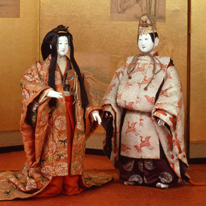Past Exhibitions
- Feature Exhibition: Hina Matsuri and Japanese Dolls
- February 21, 2015 - April 7, 2015
The Kyoto National Museum, welcomes spring this year with a revival of its beloved annual exhibition of Japanese dolls, after a six-year hiatus during the rebuilding of the museum's new wing. This year's selection includes emperor and empress dolls (dairi bina) and other hina dolls displayed on red felt, sometimes on multi-tiered altars. It also features palace dolls (gosho ningyō) and Saga dolls (saga ningyō), both representing children, as well as tiny Kamo dolls (kamo ningyō), with their simple but lively charm.
Hina dolls are associated with the Doll Festival, or hina matsuri, which takes place on March 3rd each year. Though widely considered to be an ancient ritual, the tradition of displaying and celebrating dolls on a specific day dates only to the early 1600s, in the Edo period. The Doll Festival originated as a purification rite that took place on the third day of the third month each year. Dolls originally functioned as katashiro—inanimate substitute representations used to absorb impurities and evils from actual people. These representations could then be floated away or otherwise destroyed, taking human pollutants with them. It was during the Edo period that such ritual objects were transformed into the luxurious figurines we know today.
Some types of Edo period hina dolls are named after the time periods with which they are associated, as in the Kan'ei dolls (kan'ei bina, named after the Kan'ei era, 1624–1645) or Kyōhō dolls (kyōhō bina, after the Kyōhō era, 1716–1736). The jirōzaemon bina dolls are named after a Kyoto doll maker, Jirōzaemon, who is credited with their design. The Kokin dolls (kokin bina) are considered to be a new Edo period innovation, while the courtier dolls (yūsoku bina) faithfully represent the costume and hair conventions of the aristocracy. This extensive selection of dolls offers you the opportunity to look carefully at differences in their details, including facial expressions, gestures, and costumes.
The highlights of the exhibition this year are the large central hina altars with pavilions— exemplifying a now-rare display style formerly found in Kyoto, Osaka, and other areas of the Kansai region. One of these is a newly donated ensemble commissioned for a baby girl in the year 1844. The significance of the Kyoto National Museum's collection should be evident from the high quality of the works on view. We hope that its appeal will extend to visitors of all ages.












